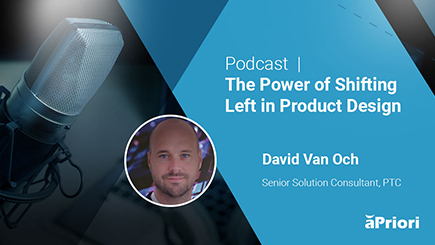Decoding Design Buzzwords: Agile, Holistic, and Shift Left in Manufacturing
Key Takeaways:
- Agile, holistic design, and shift left in manufacturing boost the efficiency and speed of new product development operations
- aPriori provides actionable cost, carbon, and manufacturability insights that augment the power of advanced product development approaches
The Full Article:
Agile, holistic, and shift left are all design methodologies that enable manufacturers to evaluate, test, and validate products earlier in the development process. Companies employ these approaches to identify and address potential issues or vulnerabilities faster, leading to significant cost savings, improved efficiencies, and higher-quality products.
Delve deeper into each approach and understand how product development teams leverage them to eliminate bottlenecks and accelerate the launch of their competitive innovations.
Traditional vs. New Approaches in Hardware Product Development Workflows
Organizations using traditional hardware product development approaches follow a linear, step-by-step process flowing through the design, prototyping, testing, and production phases. These strategies, commonly known as “waterfall” approaches, require teams to complete one phase before proceeding to the next. This process causes the following consequences:
- Long development times result in time-to-market (TTM) delays, preventing teams from meeting the dynamic needs of customers and relevant stakeholders
- Inflexibilities emerge since it is difficult to revisit and make changes to an already-completed development phase
- Identifying critical issues late in the development cycle often requires costly, time-consuming adjustments
To overcome these challenges, discrete manufacturers now implement agile and shift-left approaches, which originated in software development, into their product design processes. These methods, along with holistic design, enable manufacturers to:
- Achieve a more flexible and iterative development process to refine designs quickly and with precision
- Adapt to new requirements and issues as they emerge, regardless of the development stage
- Break down organizational silos and improve teamwork across the development cycle for faster, more informed decision making
Compare Agile, Holistic, and Shift-Left Approaches in Product Development
Forward-thinking companies leverage agile, holistic, and shift-left design approaches to increase their productivity and accelerate the TTM of products. Compare and evaluate each design methodology below.
What’s Agile Development?
Traditionally used for software testing and development, agile now extends to tangible products, providing cross-functional project teams with greater flexibility and iterative freedom.
According to McKinsey & Company, organizations that adopt an agile approach to product development can improve launch times by an impressive 60%. This acceleration in TTM results from several key aspects of agile methodologies, including:
- Continuous feedback loops to test and refine designs gradually and incrementally
- Breaking down projects into small, manageable “sprints” and aligning all team members with critical project goals
- The ability to pivot, re-prioritize tasks, and respond to changes or uncertainties quickly and more effectively
What’s Holistic Design?
Holistic design thoroughly assesses all critical, interconnected aspects of the product development cycle, including design functionality and the end-user experience. Our video, “Best Practices for Holistic Design,” explains how this approach serves as a framework to evaluate how decisions on parts, products, and assemblies influence manufacturing outcomes.
Companies that leverage holistic design manage product development issues faster and reduce costly redesigns. Moreover, they make informed design decisions to comply with sustainability regulations and satisfy customers’ demands for greener, cutting-edge products.
What’s a Shift-Left Approach?
Shift left in manufacturing enables companies to evaluate, virtually test, and validate designs earlier in the product development process, preventing costly downstream issues.
By addressing these critical tasks early, companies can make more informed decisions, enhance product quality, and elevate profitability, manufacturability, and sustainability outcomes.
Which New Product Development Methodology Best Suits You?
Companies thoroughly assess, determine, and adopt the new product development methodology that best aligns with their goals and needs. For instance, one organization might select the agile approach for rapid iterations and higher levels of flexibility. Another might choose a holistic design methodology to evaluate all critical factors of the product development process. Some might opt for a shift-left approach to address potential issues early in the development cycle.
Regardless of the selected methodology, organizations can enhance the efficiency of the product development process, resulting in higher quality and timely final products.
How aPriori Supports New Product Development Approaches
aPriori provides a digital co-pilot that empowers companies to make early, informed product design decisions to achieve cost, manufacturability, and sustainability goals simultaneously. Moreover, the platform’s automated, AI-powered design and sourcing insights enable organizations to achieve the following results:
- Improve profit margins: Companies accelerate product launch times and reduce costs in existing product lines.
- Unlock revenue growth: Organizations increase revenue and margins while maximizing resource allocation.
- Minimize risk: Teams lower manufacturing and overhead costs to improve profitability outcomes.They also meet product launch and delivery dates to increase organizational cash flow and revenue.
- Achieve environmental goals: Companies enhance their reputation, satisfy and retain environmentally conscious stakeholders, and reduce carbon and energy utilization to improve margins.
aPriori delivers these game-changing outcomes through fast automation with minimal inputs, including 3D CAD geometry evaluations, bulk cost analysis, and PLM integrations. The platform also offers out-of-the-box digital factories with regions, processes, and materials, and it simulates product cost, carbon, and manufacturability to enhance decision making.
Boost Your Competitiveness With Advanced Development Approaches
Forward-thinking manufacturers integrate agile, holistic design, and shift-left approaches into their product development operations. They streamline workflows, gain design flexibility, and identify and resolve critical product issues earlier in the development cycle.
Moreover, organizations augment the effectiveness of these new product development methodologies with aPriori, a platform that provides actionable insights to help deliver high-quality products on time.
The Power of Shifting Left in Product Design
Discover how shifting left in product design empowers teams to make informed decisions that impact cost, manufacturability, and sustainability.








